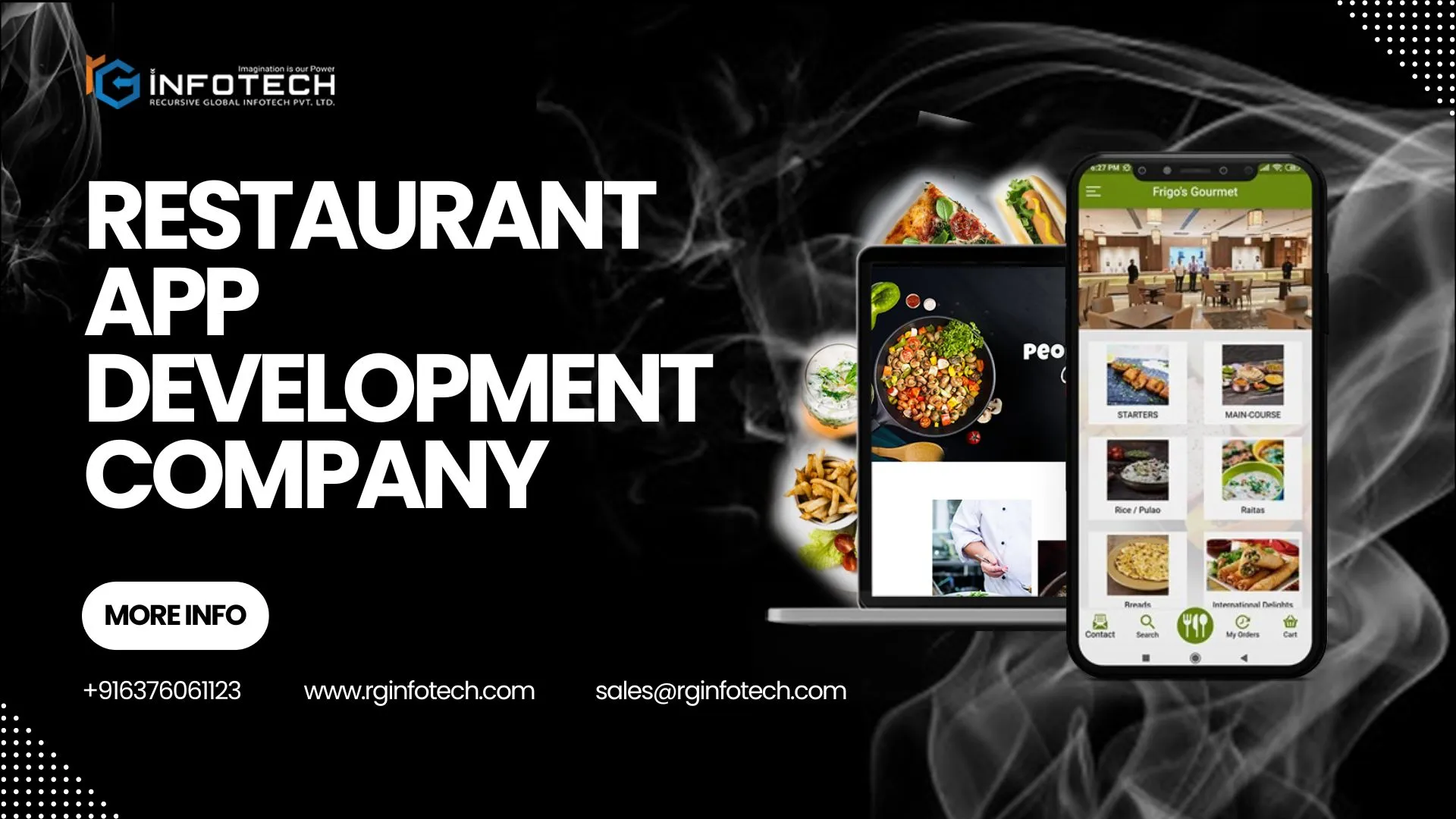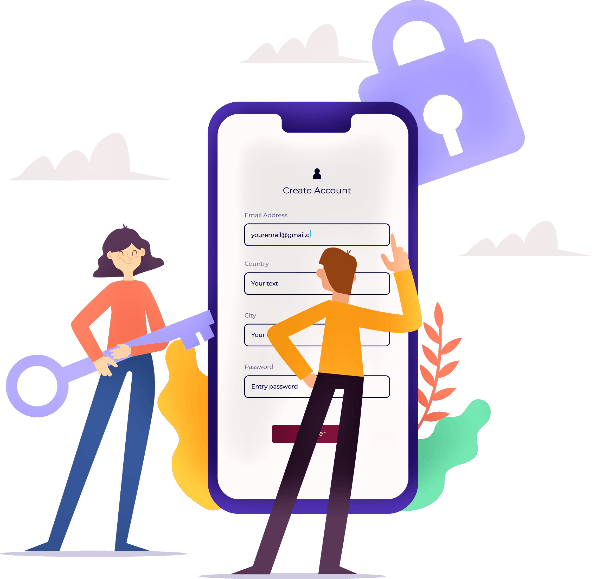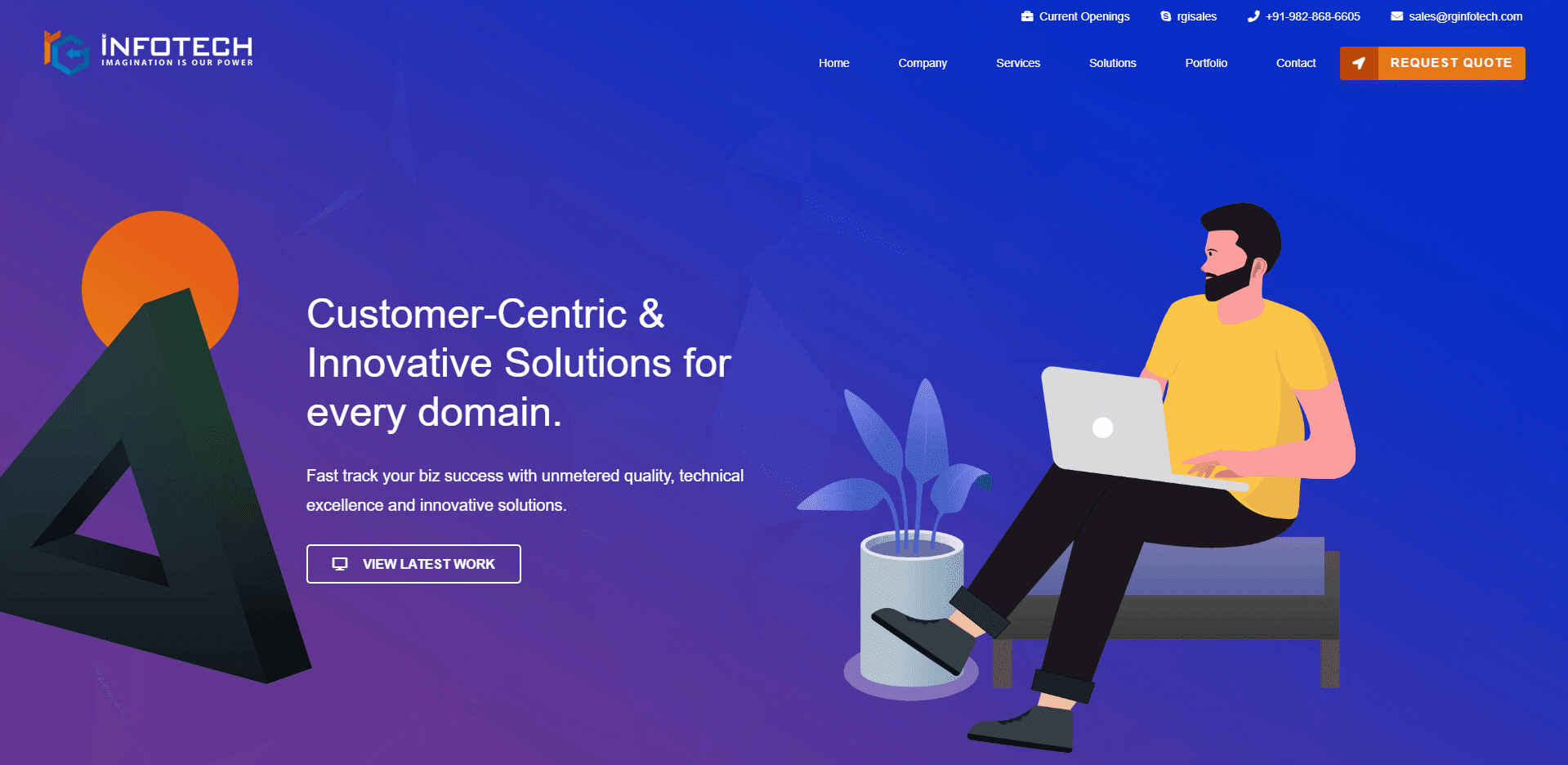Restaurant App Development Company

Restaurants and apps are like a perfect combination of salt and pepper. Food delivery apps will be one of the most popular and downloaded applications in 2024. Mobile apps are expected to bring over $935 billion in revenue this year. With 1.96 million apps available on the Apple App Store and 2.87 million on Google Play, mobiles have become a necessity in our lives, and every industry depends on mobile in one way or another. For restaurants, not having an app means missing out on a significant portion of popular business. Mobile users prioritize convenience, making restaurant apps essential for staying competitive.
Not only that, if you note the importance of restaurant apps in today’s society, it just goes down to see how true it is; you can’t restrict dining out solely on laptops or phones. Recognising the challenges faced by entrepreneurs and restaurant owners in navigating the complexities of app development, we’ve curated this blog to provide valuable insights and guidance. So, step into this amazing world and explore the exciting possibilities that restaurant app development offers. Not only that, if you consider the importance of restaurant apps in today’s world, or if it just goes down to show the underlying truth that it’s impossible to restrict dining out solely on phones or laptops.
Increase sales and customer loyalty with a mobile app.
What is A Restaurant App?
A restaurant booking mobile application is a specialised app customised according to the specific restaurant concept or chain. Whether you use an Android or iPhone, mobile apps have become an important part of daily life. Typically, restaurant apps focus on facilitating online ordering, but they can also provide valuable information about the restaurant’s loyalty program, specials, and ongoing promotions. Some restaurant apps have features like online table reservations or checking waitlist status.
For many large chain restaurants, having an app is essential. Starbucks, for example, transformed the ordering experience with its mobile apps. Starbucks boasts the second-largest number of mobile payment users in the United States, with 31.2 million users, trailing only behind the Apple wallet app itself. For many large chain restaurants, having an app is essential. For example, Starbucks transformed the ordering experience with its mobile apps.
What Are The Types Of Restaurant Apps?
Examples of restaurant apps, across both mobile and web apps, include the following:
- Table Booking Apps: Table booking apps allow users to reserve tables at restaurants in advance. Users can browse available restaurants, select a preferred date and time, and make a reservation directly through the app. These apps simplify the process of making reservations for both restaurant staff and users. Reducing what times and encouraging seamless dining apps.
- On-Demand Food Delivery Apps: On-demand food delivery applications connect local restaurants and users by offering delivery services. Users can browse menus, place orders, and have food delivered to their doorstep. These applications often partner with restaurants to provide a wide spectrum of cuisines and dining options, catering to user’s preferences and cravings.
- Inventory Management: Designers design these inventory management applications to help restaurants track and effectively manage their inventory. These apps allow restaurant owners and managers to monitor stock levels, track purchases and sales, set reordering thresholds, and generate reports. By streamlining inventory management processes, these apps help restaurants reduce waste, minimise stockouts, and optimise operations.
- Restaurant Discovery Apps: Restaurant discovery apps help users discover new restaurants and dining experiences in their area. These applications typically offer curated lists of restaurants depending on factors like location, cuisine, restaurant Android app development price, and user reviews. Users can explore restaurant profiles, read reviews, view menus, and make informed decisions about where to dine.
- In-House Restaurant Apps: In-house restaurant apps are developed and used by individual restaurants to enhance the dining experience for their customers. These apps may offer features such as online ordering, table reservations, loyalty programs, promotions, and special offers. In-house apps help restaurants engage with customers directly, build brand loyalty, and drive repeat business.
Every kind of restaurant app serves a specific purpose and caters to the different needs and preferences of both users and restaurant owners. Whether it’s booking a table, ordering food, managing inventory, discovering new dining options, or engaging with customers, restaurant apps play a crucial role in enhancing the overall dining experience.
Modules For A Restaurant App Development Company
Let’s learn more about the modules and functionalities of restaurant software, as well as the core modules. Restaurant mobile app development makes both front- and back-house operations seamless while also catering to back-office assistance. Developers create them specifically for restaurants or the food service industry.
- Inventory Management: Tracks ingredients and supplies in real time to manage stock levels efficiently.
- Point-of-Sale (POS): Handles all transactions within the restaurant, including order placement and payment processing.
- Employee Management: Streamlines recruitment, retention, training, and scheduling of staff.
- Accounting: records and tracks funds budgeted and spent, ensuring financial transparency and compliance.
- Order Management: Tracks orders from placement to payment, ensuring timely fulfillment.
- Reservations: Manages table bookings efficiently, allowing customers to reserve tables online or through the app.
- Payroll: The best restaurant app development company utilises automation of payroll processing, calculating salaries and wages for staff members.
Benefits Of Creating A Restaurant App
Some of the critical benefits of restaurant app development companies include the following:
- Reduced Development Costs: Utilising frameworks and reusable code significantly cuts down on development time and resources. This streamlined approach ensures faster delivery and cost savings, making app development accessible to restaurants with varying budgets.
- Improved Functionality: A restaurant mobile app development company specialises in crafting feature-rich apps with intuitive interfaces. These apps often incorporate advanced features like augmented reality (AR) for immersive dining experiences and direct calling options for seamless communication with waitstaff. Staff functionalities elevate user engagement and satisfaction, fostering customer loyalty and repeat business.
- Custom and Flexible Plans: Custom development plans cater to the unique needs and goals of each restaurant. Whether it’s a small bistro or a large restaurant chain, custom plans offer scalability and adaptability to suit different budgets and requirements. This ensures that restaurants can access the specific features and functionalities they need to thrive in a competitive market. Custom department plans cater to the unique needs and goals of each restaurant.
- Better Security with Encryption: Security is paramount in restaurant apps, particularly when handling sensitive customer data like payment information. App developers prioritise security by implementing robust encryption technology to safeguard user data from cyber threats. This instills confidence in customers and helps restaurants build trust and credibility in the digital landscape.
- Data Management Solutions: According to a restaurant mobile app development company, effective data management is important for protecting customer information and complying with regulations. App developers implement data management solutions that adhere to industry standards, ensuring the secure handling of customer data.
- Professional Communication: App development companies maintain clear and consistent communication with restaurant owners throughout the development process. This ensures that the app aligns with the restaurant’s vision and requirements. Professional communication also enables effective marketing and promotion, helping restaurants attract new customers and enhance brand visibility.
If you are considering restaurant app design and development, getting a free quote from mobile app development experts is usually a great idea. This is especially true if you’re a non-developer or designer in search of help.
What Are The Major Features Of Restaurant Mobile Apps?
Your restaurant mobile app will need to provide a lineup of essential features that the app can’t function without overall.
- Powerful Dashboard: A robust dashboard is what we need to incorporate into the restaurant booking app. It provides valuable insights into sales data, customer feedback, and inventory management. It also empowers owners to make more informed decisions, optimise operations, and enhance the overall dining experience.
- Location-Based Menus: This feature of restaurant applications customise menu offerings depending on the location of the user. This functionality allows users to view menu options that are specific to nearby restaurants or locations. It enhances the user experience by providing relevant and targeted menu options depending on their location, making it easier for them to discover nearby dining options and make informed choices.
- Easy Menu Display: This is one of the most important features of restaurant applications. An easy menu display streamlines the ordering process, improves customer satisfaction, and encourages repeat business by presenting menu options in a user-friendly and visually appealing manner.
- Push Notifications: The push notifications mechanism serves as a potent tool for restaurants to establish effective communication channels with their customers, fostering engagement and boosting sales. However, it’s crucial to exercise caution and discretion in its use to ensure a positive user experience. By providing timely and relevant notifications that add value to users’ dining experiences, restaurants can avoid being perceived as intrusive or spammy.
- Embeddable Media Content: Embeddable media content enriches the user experience within restaurant apps or websites by incorporating visually appealing elements such as images, videos, and interactive features. These multimedia elements serve multiple purposes, including showcasing menu items, providing virtual tours of the restaurant, highlighting chef profiles, and sharing customer testimonials.
- Online payment system: An online payment system is a cornerstone feature of restaurant apps, facilitating secure and convenient transactions for customers directly within the app interface. By integrating this functionality, customers can seamlessly complete their orders without the hassle of handling cash or physical cards. This not only enhances the overall user experience by offering speed and efficiency but also promotes contactless transactions, aligning with evolving health and safety preferences.
- Live food tracking: For restaurants, live food tracking streamlines order management and delivery logistics, optimising operational efficiency and ensuring timely service. By offering this feature, restaurants demonstrate reliability and commitment to customer satisfaction, fostering trust and loyalty among their clientele. For restaurants, live food tracking streamlines order management and delivery logistics, optimising operational efficiency and ensuring timely service.
- Loyalty program: A loyalty program is a strategic initiative implemented within restaurant apps to cultivate and maintain customer loyalty. Through this program, customers accrue points or rewards for every purchase made through the app. These rewards are redeemable for various incentives, such as discounts, free items, or exclusive offers, encouraging repeat visits and fostering long-term relationships between customers and the restaurant brand.
- Integration with social media indeed enhances the reach, visibility, and engagement of restaurant apps, empowering them to harness the influence of social networks. By seamlessly connecting with platforms like Facebook, Instagram, Twitter, and others, restaurants can extend their presence beyond the app itself, reaching a broader audience of potential customers.
- Help and Support: Help and support features are pivotal elements within restaurant apps, serving as a guiding hand for users navigating the platform. These functionalities encompass a range of support mechanisms, including FAQs, live chat support, contact information access, order tracking assistance, and feedback channels. By offering comprehensive support resources, restaurants demonstrate their commitment to providing exceptional service and resolving user queries promptly.
Common Technologies For Restaurant App Development
There are a few basic technologies that are often used while designing restaurant-centric mobile apps:
- HTML5 (Hypertext Markup Language): This is HTML’s brand new version, the standard markup language that app developers and designers use to create restaurant mobile app UI design or web design. It offers the structure and web pages, including text, images, links, and multimedia elements.
- JavaScript: When talking about the most versatile programming language, Javascript takes the top place. It is used to develop the best apps for restaurants to add more interactive elements, handle user input, manipulate the content of HTML, and communicate with the web servers.
- CSS (Cascading Style Sheets): CSS is considered a style sheet language, which developers use to define the presentation and layout of HTML documents. It allows developers to control the appearance of web pages, including Fonts, colors, spacing, and positioning.
- React Native: React Native Is included in the list of the most popular open-source frameworks developed by Facebook for developing cross-platform mobile applications using Javascript and React. It allows developers to write code once and deploy it on multiple platforms, including iOS, Android, and the Web.
- Flutter: Flutter is a UI toolkit developed by Google for building natively compiled applications for mobile, web, and desktop from a single codebase. It uses the Dart programming language and provides a rich set of customisable widgets for building beautiful and performant user interfaces.
Each of these technologies plays a crucial role in modern web and mobile app development, offering developers the tools and capabilities needed to create engaging and responsive applications for a wide range of platforms and devices.
How Do You Create A Mobile App For Your Restaurant?
One of the most commonly asked questions is “How do I create a restaurant app?” The journey to create a restaurant app requires you to assume a systematic approach to the process aimed at producing a top-notch user experience and successful market penetration. Here’s a concise breakdown of the suggested restaurant app development services and development steps.
- Ideate and decide what you want to build. Clarify your vision for the restaurant app, identifying its unique value proposition and key functionalities.
- Conduct solid market research: explore the market dynamics, analyse competitors, target audience preferences, and emerging mobile app development trends to inform strategic decision-making.
- Design the UX/UI of your app: Select the best designers from a reputable restaurant app development agency. Take a UX-oriented product design approach to craft an intuitive and visually appealing user interface, ensuring a delightful experience.
- Decide on core app features for MVP development: Define the minimum viable product features that are essential for a successful initial launch, focusing on core functionalities to expedite development.
- Speed up development using 3rd-party APIs: Incorporate third-party APIs for essential features like gateways, maps, and order delivery to accelerate development without compromising quality.
- Test, deploy, and launch the app. Rigorous testing leads to bug-free software. Deploy and launch your restaurant app, making sure your target audience gets access to a well-rounded platform.
- Run user acquisition marketing campaigns: Execute targeted campaigns to attract users, leveraging various channels to maximise campaign to maximise reach.
- Analyse feedback from early adopters: Gather and analyse feedback from early users, understanding their experiences and preferences to inform future iterations.
- Fix bugs and start iteration for the next version. Address identified issues, fix bugs promptly, and initiate the iterative process for the next version of your restaurant app, keeping it dynamic and responsive to user needs.
How Much Does It Cost to Build a Restaurant App?
The restaurant app development cost is somewhere around $2,000 to $8,000 for the most basic features and functions such as online delivery, dashboard, etc. Developing a restaurant app for a global chain can cost somewhere between $20,000 and $40,000, which may entail losing out on certain features like online table reservations, opening hours, and a price list. restaurant business owners should engage with developers and discuss legal terms before launching the application.
The hourly rates charged by app developers can differ depending on market value and geographic location. For example, developers in the U.S. typically cost around $150 per hour, while in Europe, the rate is somewhere around $75, and here in India, it costs around $25. As for the factors that contribute to the cost of restaurant app development, here are some of them:
- Features set
- Mobile app design
- Team size
- Location of the agency
- App complexity
- Tech stack used
- A platform for application deployment
- Features set
Conclusion
The above provides details and information about restaurant app development company, showcasing the range of tech features and costs associated with creating such apps. By leveraging this information, restaurant owners can make informed decisions and embark on the journey of creating a tailored app that meets the unique requirements of their establishment.
Frequently Asked Questions (FAQs)
Core features such as menu browsing, ordering, payments, push notifications, and location services are essential. Additional features like online table reservations and opening hours may vary depending on the restaurant’s needs.
The cost of developing a restaurant app can range from $8,000 to $40,000 or more, depending on the complexity and scope of features required. Simple apps may start at the lower end of the spectrum, while more advanced apps for global chains may incur higher costs.
Factors such as the complexity of features, design requirements, development time, platform compatibility (iOS, Android), and the hourly rate charged by developers all impact the overall cost.
Researching and reaching out to reputable app development companies, reviewing their portfolios and client testimonials, and negotiating terms are essential steps in finding a reliable developer.



 rgisales
rgisales



